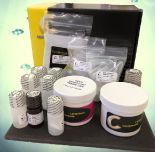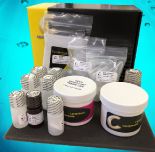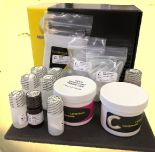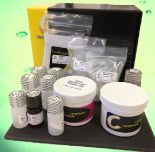Signal-Seeker™ Acetyl-Lysine Detection Kit (30 assay)
The Signal-Seeker™ line of produts have been developed to allow simple analysis of key regulatory protein modifications by specialists and non-specialists alike. The comprehensive Signal-Seeker™ kits provide an affinity bead system to isolate and enrich modified proteins from any given cell or tissue lysate. The enriched protein population is then analyzed by standard western blot procedures using a primary antibody to the target protein.
Product Uses Include
- Investigate transient regulatory mechanisms
- Measure signalling events of multiple pathway member proteins
- Discover new modifications of your protein of interest
- Gain insight into regulatory mechanisms
- Measure endogenous or transiently expressed protein signalling events
Validation Data: Acetyl-Lysine Detection Kit White Paper
Kit contents
The acetyl-lysine kit contains the following components:
| Lysis and protein quantitation step | IP and pre-clear step | Wash step | Elution step | Western step |
BlastR™ Lysis Buffer BlastR™ Dilution Buffer BlastR™ Filters Protease Inhibitor Cocktail HDAC inhibitor Cocktail Precision Red™ Protein Assay Reagent | Acetyl Lysine Affinity Beads IP Control Beads
| BlastR™ Wash Buffer
| Spin Columns Bead Elution Buffer
| Chemiluminescent Reagent A Chemiluminescent Reagent B Anti-Acetyl Lysine-HRP antibody
|
Example results
There are many applications for these kits, here we describe an interesting example:
Application 1: Investigate significant Acetylation events
Immunoprecipitation using the Signal-Seeker™ Acetyl-Lysine Detection Kit compared to cell signaling acetyl lysine antibody and immunechem acetyl lysine affinity beads
Figure 1. Various acetyl-lysine affinity reagents were used to IP acetylated proteins from Cos-7 cells either treated (+) or untreated (-) with TSA (1 μM) and nicotinamide (1 mM) for 6 hours. (1) 16.7 μl of AAC04 bead slurry (20 μg antibody). (2) 50 μl of AAC04 bead slurry (60 μg antibody). (3) Anti-acetyl lysine rabbit monoclonal mix (Cell Signaling, 1:100 per manufacturer’s instruction). (4) ImmuneChem acetyl lysine affinity bead (40 μg antibody). (5) ImmunChem acetyl lysine bead (80 μg antibody). (6) Normal mouse IgG control bead (60 μg antibody). The total profile of enriched acetylated proteins were eluted and analyzed by western blot with an AAC03-HRP antibody (1:3000). AAC04 performed exceptionally well in enriching a broad range of acetylated proteins whereas the other commercial acetyl lysine enrichment reagents primarily enriched the most abundance acetylated proteins (e.g. acetylated tubulin and histones).
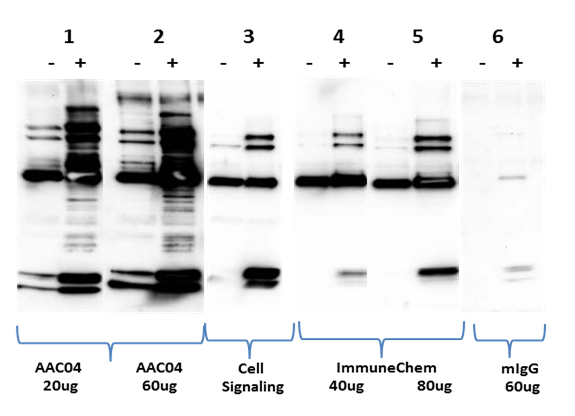
Immunoprecipitation of target specific acetylated proteins using the Signal-Seeker™ Acetyl-Lysine Detection Kit
Figure 2A: A431 cells, untreated (-) or treated (+) with 1 μM TSA and 1 mM nicotinamide for 6 hours, were isolated using BlastR buffer. IP was performed using AAC04 beads (60 μg). Total cell lysate (Input) and immunoprecipitated samples were separated by SDS-PAGE and analyzed by western blot with antibodies against EGFR (Millipore, 1:1000), Hsp90 (Abcam, 1:20,000), P53 (Sigma, 1:2000), and RhoDGI(Millipore,1:1000)
Immunoprecipitation of acetylated proteins from liver and heart tissue using the Signal-Seeker™ Acetyl-Lysine Detection Kit
Figure 2B: Mouse tissue extracts (liver and heart) were obtained with BlastR buffer. IP was performed using AAC04 beads (60 μg) or mIgG control bead (#CIG02, 60 μg) in 1mg of tissue extracts. Enriched proteins were separated by SDS-PAGE and analyzed by western blot with AAC03-HRP (1:3000).
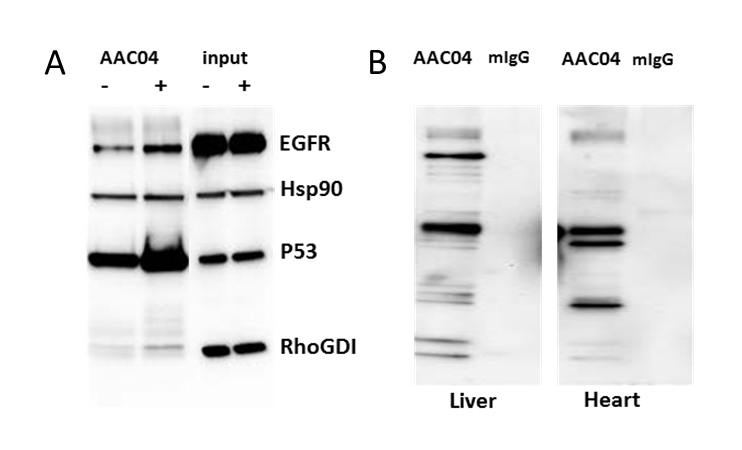
• Pharmacological investigation of acetylating and HDAC enzymes involved in regulation of target proteins.
• Investigate acetylation under a variety of different growth factors or drug treatments.
• Examine the interaction of acetylated target proteins with its downstream effectors.
• Examine crosstalk between acetylation and other PTMs for target proteins.
For more information contact: signalseeker@cytoskeleton.com
Associated Products:
Signal-Seeker™ Phosphotyrosine Detection Kit (Cat. # BK160)
Signal-Seeker™ Ubiquitination Detection Kit (Cat. # BK161)
Signal-Seeker™: BlastR™ Rapid Lysate Prep Kit (Cat. # BLR01)
Signal-Seeker™ Acetyl-Lysine Affinity Beads (Cat.# AAC04-beads)
Signal-Seeker™: PTMtrue™ Acetyl-lysine Antibody (Cat.# AAC03)
Visit our Signal-Seeker™ Tech Tips and FAQs page for technical tips and frequently asked questions regarding this and other Signal-Seeker™ products click here
If you have any questions concerning this product, please contact our Technical Service department at tservice@cytoskeleton.com




